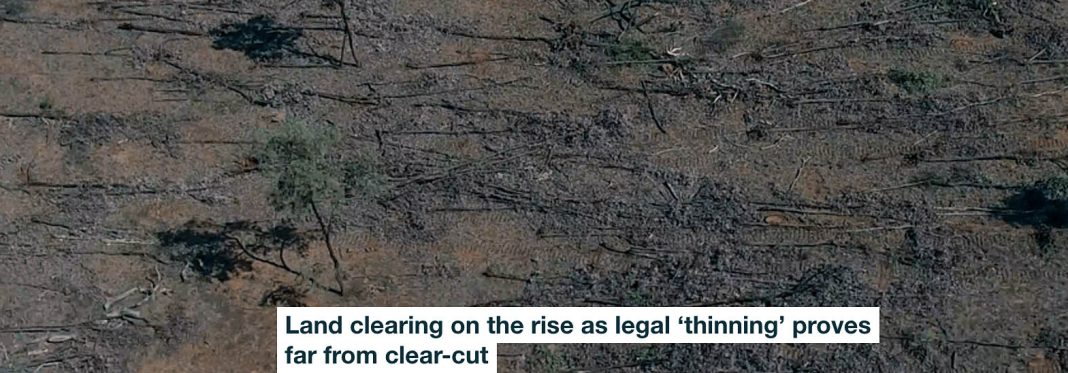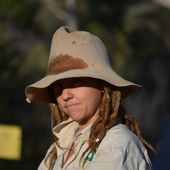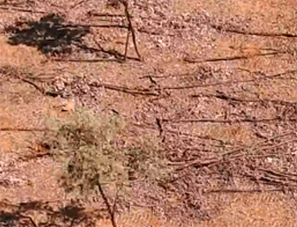 A ‘thinned’ landscape, which provides far
from ideal habitat for many species.
A ‘thinned’ landscape, which provides far
from ideal habitat for many species.
Land clearing is accelerating across eastern Australia, despite our new research providing a clear warning of its impacts on the Great Barrier Reef, regional and global climate, and threatened native wildlife.
Policies in place to control land clearing have been wound back across all Australian states, with major consequences for our natural environment.
One of the recent policy changes made in Queensland and New South Wales has been the introduction of self-assessable codes that allow landholders to clear native vegetation without a permit. These codes are meant to allow small amounts of “low-risk” clearing, so that landholders save time and money and government can focus on regulating activities that have bigger potential impacts on the environment.
However, substantial areas of native forest are set to be cleared in Queensland under the guise of vegetation “thinning”, which is allowed by these self-assessable codes. How did this happen?
Thin on the ground
Thinning involves the selective removal of native trees and shrubs, and is widely used in the grazing industry to improve pasture quality. It has been argued that thinning returns the environment back to its “natural state” and provides better habitat for native wildlife. However, the science supporting this practice is not as clear-cut as it seems.
Vegetation “thickening” is part of a natural, dynamic ecological cycle. Australia’s climate is highly variable, so vegetation tends to grow more in wetter years and then dies off during drought years. These natural cycles of thickening and thinning can span 50 years or more. In most areas of inland eastern Australia, there is little evidence for ongoing vegetation thickening since pastoral settlement.
Thinning of vegetation using tractors, blades and other machinery interrupts this natural cycle, which can make post-drought recovery of native vegetation more difficult. Loss of tree and shrub cover puts native wildlife at much greater risk from introduced predators like cats, and aggressive, “despotic” native birds. Thinning reduces the diversity of wildlife by favouring a few highly dominant species that prefer open vegetation, and reduces the availability of old trees with hollows.
Many native birds and animals can only survive in vegetation that hasn’t been cleared for at least 30 years. So although vegetation of course grows back after clearing, for native wildlife it’s a matter of quality, not just quantity.
Land clearing by stealth?
Thinning codes in Queensland and New South Wales allow landholders to clear vegetation that has thickened beyond its “natural state”. Yet there is little agreement on what the “natural state” is for many native vegetation communities.
Under the Queensland codes, up to 75% of vegetation in an area can be removed without a permit, and in New South Wales thinning can reduce tree density to a level that is too low to support natural ecosystems.
All of this thinning adds up. Since August 2016, the Queensland government has received self-assessable vegetation clearing code notifications totalling more than 260,000 hectares. These areas include habitat for threatened species, and ecosystems that have already been extensively cleared.
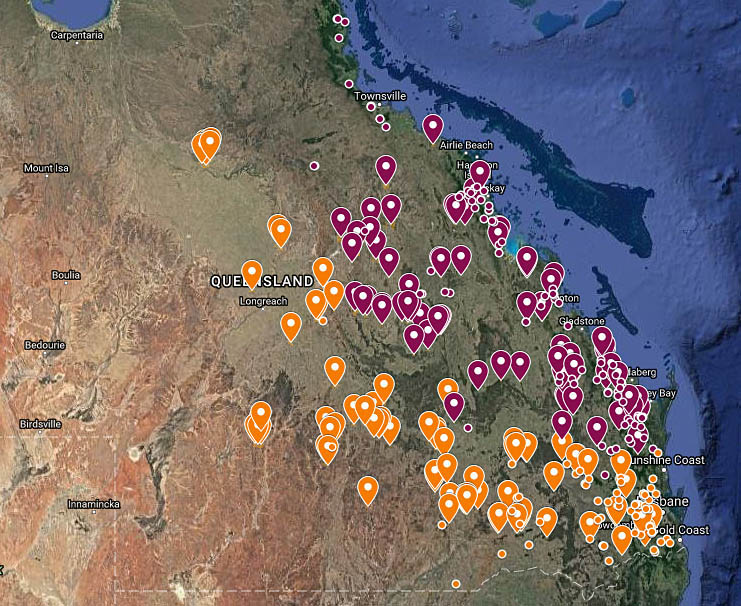
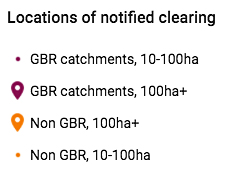
It may be that the actual amount of vegetation cleared under thinning codes is less than the notifications suggest. But we will only know for sure when the next report on land clearing is released, and by then it will be too late.
Getting the balance right
Vegetation policy needs to strike a balance between protecting the environment and enabling landholders to manage their businesses efficiently and sustainably. While self-regulation makes sense for some small-scale activities, the current thinning codes allow large areas of vegetation to be removed from high-risk areas without government oversight.
Thinning codes should only allow vegetation to be cleared in areas that are not mapped as habitat for threatened species or ecosystems, and not to an extent where only scattered trees are left standing in a landscape. Stronger regulation is still needed to reduce the rate of land clearing, which in Queensland is now the highest in a decade.
Protecting native vegetation on private land reduces soil erosion and soil salinity, improves water quality, regulates climate, and allows Australia’s unique plants and animals to survive. Landholders who preserve native vegetation alongside farming provide essential services to the Australian community, and should be rewarded. We need long-term incentives to allow landholders to profit from protecting vegetation instead of clearing it.
Our research has shown that Australian governments spend billions of dollars trying to achieve the benefits already provided by native vegetation, through programs such as the Emissions Reduction Fund, the 20 Million Trees program and Reef Rescue. Yet far more damage is inflicted by under-regulated clearing than is “fixed” by these programs.
Imagine what could be achieved if we spent that money more effectively.
This article was co-authored by:
April Reside – [Researcher, Centre for Biodiversity and Conservation Science, The University of Queensland];
Research Assistant in the Centre for Biodiversity and Conservation Science, The University of Queensland
Post-doctoral research fellow, The University of Queensland
Landscape Ecologist, The University of Queensland
Postdoctoral Research Fellow, Environmental Policy, The University of Queensland
This article is part of a syndicated news program via the Conversation

